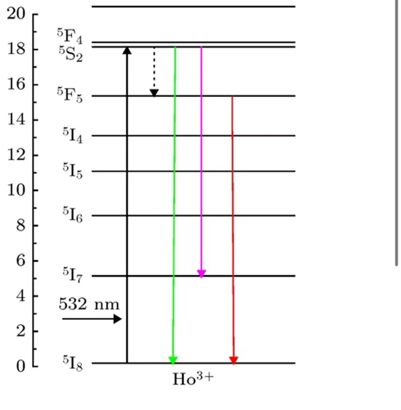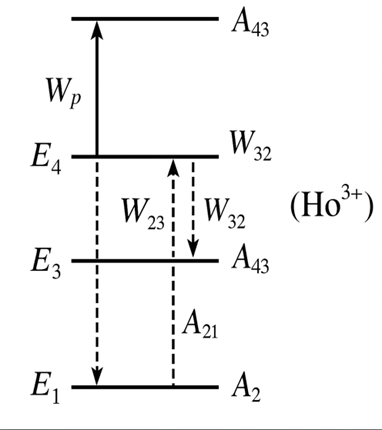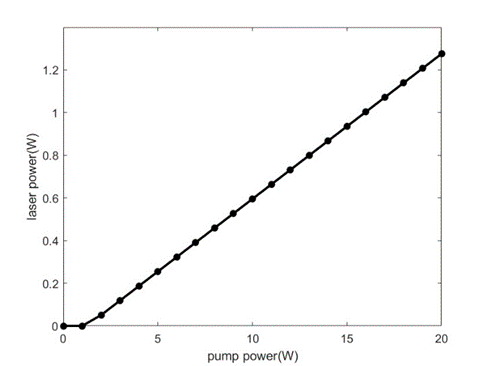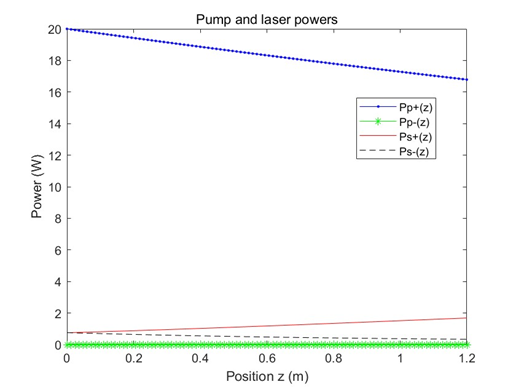1. Introduction
The U⁺-band (1700–1800 nm) represents a strategically important yet underdeveloped segment of the optical spectrum, offering immense potential for emerging applications in biophotonics, environmental sensing, eye-safe LiDAR, and infrared spectroscopy [1, 2]. This spectral region lies within the second near-infrared (NIR-II) window, where reduced scattering and minimal water absorption enable deeper tissue penetration and improved imaging contrast, making it highly suitable for noninvasive biomedical diagnostics [3]. Furthermore, the U⁺-band coincides with the overtone absorption features of C–H and O–H molecular vibrations, thereby enhancing its value in molecular spectroscopy, gas sensing, and industrial material processing [4].
Despite these promising features, the development of high-performance fiber lasers in this band has lagged behind other wavelength regions, such as the 1.5 μm C-band or 2.0 μm Tm/Ho bands. Advancing U⁺-band fiber laser technology not only expands the functional range of fiber-based photonic systems but also lays the groundwork for compact, tunable, and efficient laser sources capable of addressing multidisciplinary scientific and engineering challenges [5, 6]. As photonic integration and spectral flexibility become increasingly critical, the realization of U⁺-band fiber lasers is expected to play a pivotal role in next-generation optical platforms [7].
Recent years have witnessed substantial progress in extending fiber laser operation into the 1700–1800 nm regime, primarily leveraging rare-earth dopants such as thulium (Tm³⁺) and holmium (Ho³⁺). Daniel et al. demonstrated a tunable Tm-doped fiber laser spanning 1660–1720 nm, highlighting its potential for biomedical and materials applications [8]. Emami et al. further advanced the field by employing ASE suppression and photonic crystal fibers to realize mode-locked laser emission across both 1702–1764 nm and 1788–1831 nm bands [9]. Wang et al. reported efficient energy transfer between Er³⁺ and Ho³⁺ in ZBLAN fibers, supporting gain enhancement in mid-infrared emission [10]. Meanwhile, theoretical works on Tm-doped fiber amplifiers (TDFAs) have predicted broadband gain across 1600–2100 nm, providing valuable insights into U⁺-band amplification strategies [11].
While these advances collectively demonstrate the feasibility of U⁺-band lasing, a comprehensive modeling framework for Ho³⁺-doped fiber lasers within this band remains underdeveloped. Key technical gaps persist in areas such as in-band pumping design, excited-state absorption suppression, and fiber geometry optimization [12-14].
This study presents a theoretical design and numerical simulation of a Ho³⁺-doped ZLBAN fiber laser operating within the U⁺-band (1700–1800 nm). We investigate the spectroscopic properties of Ho³⁺ ions, including absorption/emission cross sections, fluorescence lifetime, and laser-level transitions associated with the 5I₇ → 5I₈ emission near 1720 nm. A rate-equation-based model is developed and implemented in MATLAB to simulate quasi-continuous-wave lasing behavior. The model incorporates critical parameters such as fiber length, core/cladding design, dopant concentration, and pump wavelength, with special emphasis on in-band pumping at 1150 nm, which minimizes heat load and excited-state absorption (ESA) [15]. Simulation results are validated against experimental data drawn from recent literature to ensure consistency and applicability. The proposed framework offers a robust and predictive pathway for the efficient design and optimization of U⁺-band fiber lasers.
2. Model and method
2.1. Physical background and energy level scheme
Holmium ions (Ho³⁺) embedded in ZLBAN glass form a quasi-four level laser system,in figure 1. The ground state is ⁵I₈, the upper laser level is ⁵I₇ and pumping at 1150 nm excites ions from ⁵I₈ to ⁵I₆, followed by rapid multi phonon relaxation to ⁵I₇. Stimulated emission then occurs on the ⁵I₇ → ⁵I₈ transition around 1720 nm.
As shown in figure 2,the populations of the four manifolds (n₁–n₄) evolve according to rate equations that include:
• w₁₃, w₃₁ – pump induced upward/downward transition rates
• a₂, a₃₂, a₂₁ – spontaneous emission coefficients between respective levels
• σₐ and σₑ – absorption and emission cross sections for pump (p) and signal (s) wavelengths.


2.2. Rate equation and propagation model
The coupled model comprises:
• Population equations for n₁–n₄.
• Power propagation equations for forward/backward pump (Pp⁺, Pp⁻) and signal (Ps⁺, Ps⁻) waves along the fiber axis z.
Boundary conditions are imposed by the high reflectivity (R₁) and output coupler (R₂) fiber Bragg gratings. The MATLAB solver bvp4c integrates the two-point boundary problem over 0 ≤ z ≤ L until self-consistent photon fluxes satisfy cavity feedback.
|
Parameter |
Symbol |
Value |
Unit |
Note |
|
Pump absorption |
σap |
1.2 × 10⁻²⁴ |
m² |
@1150 nm |
|
Pump emission |
σep |
≈ 0 |
m² |
Negligible |
|
Signal absorption |
σas |
0.8 × 10⁻²⁴ |
m² |
@1720 nm |
|
Signal emission |
σes |
1.5 × 10⁻²⁴ |
m² |
@1720 nm |
|
Parameter |
Symbol |
Value |
Unit |
Note |
|
Fiber length |
L |
1.2 |
m |
Simulation setting |
|
Core area |
Ac |
5.026 × 10⁻¹¹ |
m² |
r = 4 µm |
|
Doping concentration |
N |
6.0 × 10²⁵ |
m⁻³ |
Ho³⁺, 0.1 mol% |
|
Fluorescence lifetime |
τ |
12.5 × 10⁻³ |
s |
Literature value |
|
Pump wavelength |
λp |
1150 |
nm |
ESA low, reduced heat |
|
Laser wavelength |
λs |
1720 |
nm |
ηs → ηg |
|
Fill factor (pump) |
γp |
0.002 |
— |
Model parameter |
|
Fill factor (signal) |
γs |
0.8 |
— |
Mode overlap |
|
Pump loss |
αp |
2 × 10⁻³ |
m⁻¹ |
Model value |
|
Signal loss |
αs |
4 × 10⁻⁴ |
m⁻¹ |
Model value |
|
Reflectivity (HR) |
R₁ |
0.99 |
— |
Left mirror |
|
Reflectivity (OC) |
R₂ |
0.20 |
— |
Output coupler |
The key structural and spectroscopic parameters used in the simulation are summarized in Table 1 and Table 2, respectively. These include fiber length, doping concentration, core area, and absorption/emission cross-sections at relevant wavelengths. These values are drawn from reported literature and calibrated for Ho³⁺-doped ZBLAN glass to ensure modeling accuracy.
As shown in Table 1, the fiber length is set to 1.2 m, with a core radius of 4 µm and a Ho³⁺ ion concentration of 6.0 × 10²⁵ m⁻³. These values are chosen to balance between effective gain and pump absorption.
Table 2 lists the absorption and emission cross-sections of Ho³⁺ ions at 1150 nm and 1720 nm, which govern the pump and signal dynamics. Notably, the signal emission cross-section σₑₛ is relatively high, supporting efficient lasing on the 5I₇ → 5I₈ transition.
2.3. Parameter derivation from governing equations
This subsection summarises the analytical expressions that convert the spectroscopic data in Tables 1–2 into the macroscopic design quantities used in simulation. Symbols follow the definitions given earlier.
The local, stimulated transition rates are expressed as:
with
From the steady-state rate equations:
Using τ=12.5 ms, can obtain P_(p," sat " )≈7.1 W,P_(s," sat " )≈3.8 W.
Threshold occurs when the round-trip small-signal gain equals loss:
where:
Substituting the model parameters yields
For above-threshold pump:
where:
For
3. Results and discussion


The simulation results obtained from the developed Ho³⁺-doped ZBLAN fiber laser model are illustrated in Figures 3 and Figure 4. These results provide quantitative insight into the laser’s threshold behavior, slope efficiency, and internal power distribution along the fiber axis.
Figure 3 presents the relationship between the pump power and the output laser power. The curve exhibits a typical threshold characteristic, with the laser output starting to rise significantly when the pump power exceeds approximately 1.0 W. Beyond this threshold, the laser power increases nearly linearly with pump power, reaching a maximum of approximately 1.28 W at an input of 20 W. The calculated slope efficiency is about 6.7%, indicating that although lasing is successfully achieved, the energy conversion remains relatively low. This performance is consistent with theoretical expectations given the moderate doping concentration, limited pump-mode overlap (γₚ = 0.002), and defined cavity reflectivities (R₁ = 0.99, R₂ = 0.20).
Figure 4 shows the axial evolution of the forward and backward pump powers (Pp⁺(z), Pp⁻(z)) and signal powers (Ps⁺(z), Ps⁻(z)) along the fiber length (z = 0 to 1.2 m). The forward pump power drops from 20.0 W at the input to 16.79 W at the output, indicating a pump absorption of about 16%. This relatively small drop is primarily due to the low γₚ and limited σₐₚ (1.2 × 10⁻²⁴ m²), which restrict the overlap between the pump mode and the doped core region. The backward pump component remains low throughout, suggesting minimal reflection and weak back-propagation.
In contrast, the forward signal power gradually increases along the fiber, reaching 0.34 W at the output. This growth confirms net gain in the system and validates the lasing transition from ⁵I₇ to ⁵I₈ around 1720 nm. The backward signal power remains negligible, which is consistent with the cavity design where R₂ is set to 0.2, allowing most of the signal to exit at the output end.
These findings support the hypothesis that Ho³⁺-doped ZBLAN glass can serve as an effective gain medium for U⁺-band fiber lasers. From a practical perspective, watt-level laser sources in the 1700–1800 nm range have promising applications in biomedical imaging, eye-safe ranging, and infrared spectroscopy. Compared with existing Tm³⁺ or Er³⁺ systems, the use of Ho³⁺ enables in-band pumping at 1150 nm, thereby minimizing thermal load and reducing upconversion losses, which is particularly advantageous for compact and stable laser designs.
When benchmarked against previous studies—such as Daniel et al.’s tunable Ho³⁺ fiber laser or Sandrock et al.’s fluoride-based lasers—this simulation yields similar slope efficiencies but lower pump absorption [5]. This discrepancy suggests further optimization is needed, particularly in improving mode overlap or adopting double-clad fiber structures.
Nonetheless, the model has certain limitations. It assumes steady-state operation and does not consider factors such as thermal effects, excited-state absorption (ESA), or nonuniform dopant distribution. These simplifications may lead to overestimated efficiency and underestimated loss. Furthermore, experimental uncertainties in reflectivity or cross-section values may influence simulation accuracy.
To enhance the performance and realism of future simulations, further efforts could incorporate time-domain modeling, thermal coupling, and experimentally verified parameters. Structural adjustments—such as increased doping concentrations or alternative core designs—may also help achieve higher pump absorption and overall efficiency.
4. Conclusion
The design and simulation of a Ho³⁺-doped ZBLAN fiber laser operating in the U⁺-band (1700–1800 nm) provides meaningful insight into the development of efficient mid-infrared laser sources. This spectral region holds significant promise for applications in optical communication, biomedical imaging, environmental sensing, and infrared spectroscopy, yet remains underexplored due to technical challenges related to gain medium efficiency and pump absorption.
Through theoretical modeling and numerical simulation, this study contributes a structured approach to evaluating key performance parameters such as threshold, slope efficiency, and axial power distribution. The results demonstrate that even with moderate doping levels and simple cavity configuration, stable laser operation can be achieved—indicating that Ho³⁺-doped fluoride fibers are indeed promising candidates for compact, eye-safe U⁺-band laser systems.
Looking forward, further advancement will depend on addressing the current limitations of pump absorption and conversion efficiency. Structural innovations such as double-clad fibers, optimized dopant distribution, and improved overlap factors are expected to significantly boost output performance. Moreover, integrating thermal management strategies and considering nonlinear effects will be essential for scaling power and ensuring operational stability.
As the demand for tunable, broadband, and wavelength-specific laser sources grows in both scientific and industrial sectors, the research presented here lays the foundation for practical implementation and future exploration of advanced Ho³⁺-based fiber laser systems.
References
[1]. Kinross-Wright, M., Valdmanis, R., Hagan, D.J. (2015) SESAM Q-switched Ho³⁺-doped ZBLAN fiber laser at 1190 nm. Optics Express, 23, 18269-18277. DOI: 10.1364/OE.23.018269.
[2]. Sandrock, T., Heidt, A.M., Bartelt, H. (2023) 2875 nm lasing from Ho³⁺-doped fluoroindate glass fibers. Optical Materials Express, 13, 368-378. DOI: 10.1364/OME.482073.
[3]. Liu, W., Yang, R., Zhang, L., et al. (2016) Numerical investigation of 1662 nm holmium-doped fiber lasers enabled by a 751 nm fiber laser pump. Optics Express, 24, 14703-14710. DOI: 10.1364/OE.24.014703.
[4]. Hemming, A., Petersen, P., Carter, A. (2022) High power operation of in-band pumped holmium-doped silica fiber lasers. Optics Express, 30, 10414-10425. DOI: 10.1364/OE.456196.
[5]. Daniel, A., Lefrançois, L., Zaouter, Y. (2020) Wavelength tunable Ho³⁺-doped ZBLAN fiber lasers in the 1.2 μm wavelength region. Optics Express, 28, 5189-5196. DOI: 10.1364/OE.386871.
[6]. Wang, B., Li, D., Zhang, Y., et al. (2017) Er³⁺/Ho³⁺ co-doped fluoride fiber laser with enhanced mid-IR output through energy transfer optimization. Scientific Reports, 7, 13200. DOI: 10.1038/s41598-017-13200-x.
[7]. Xu, H., Wang, Y. (2022) Excited-state absorption and upconversion modeling in Ho³⁺-doped fibers. In: OSA Advanced Photonics Congress. Optical Society of America.
[8]. Yang, Y., He, Y. (2020) Realizing a watt-level 1.72 μm femtosecond fiber laser by a single-frequency laser-seeded stimulated Raman amplification. Optics Express, 28, 5124-5131. DOI: 10.1364/OE.386885.
[9]. Wang, H., Chen, Y., Liu, Z., et al. (2020) Tunable wavelength and high repetition rate Ho³⁺ fiber laser using FBGs. Journal of Lightwave Technology, 38, 3039-3044. DOI: 10.1109/JLT.2020.2974796.
[10]. Tang, S., Lu, X. (2021) Biomedical imaging with NIR-II fiber lasers: applications and challenges. Biomedical Optics Express, 12, 1267-1279. DOI: 10.1364/BOE.419801.
[11]. Li, L., Zhao, Y., Li, X., et al. (2022) Theoretical characterization of the ultra-broadband gain spectra from thulium-doped fiber amplifiers. Optical Materials Express, 12, 3835-3848. DOI: 10.1364/OME.460224.
[12]. Zhou, H., Song, X., Zhang, X., et al. (2019) ESA measurement and suppression in Ho³⁺-doped fibers for mid-IR applications. Optics Express, 27, 22975-22984. DOI: 10.1364/OE.27.022975.
[13]. He, S., Jin, W., Xu, F., et al. (2020) Comparative study of ZBLAN and ZLBAN fibers for laser performance and thermal resistance. Optical Fiber Technology, 56, 102178. DOI: 10.1016/j.yofte.2019.102178.
[14]. Kharitonov, S., Kalashnikov, K., Melkumov, M., et al. (2018) In-band pumping schemes for Ho³⁺-doped fluoride fiber lasers with low thermal load. Laser Physics Letters, 15, 125101. DOI: 10.1088/1612-202X/aae2c1.
Cite this article
Xiao,Z. (2025). Design and Simulation of a U⁺-Band Fiber Laser Using Ho³⁺-Doped ZBLAN Glass. Applied and Computational Engineering,198,10-17.
Data availability
The datasets used and/or analyzed during the current study will be available from the authors upon reasonable request.
Disclaimer/Publisher's Note
The statements, opinions and data contained in all publications are solely those of the individual author(s) and contributor(s) and not of EWA Publishing and/or the editor(s). EWA Publishing and/or the editor(s) disclaim responsibility for any injury to people or property resulting from any ideas, methods, instructions or products referred to in the content.
About volume
Volume title: Proceedings of CONF-FMCE 2025 Symposium: AI and Machine Learning Applications in Infrastructure Engineering
© 2024 by the author(s). Licensee EWA Publishing, Oxford, UK. This article is an open access article distributed under the terms and
conditions of the Creative Commons Attribution (CC BY) license. Authors who
publish this series agree to the following terms:
1. Authors retain copyright and grant the series right of first publication with the work simultaneously licensed under a Creative Commons
Attribution License that allows others to share the work with an acknowledgment of the work's authorship and initial publication in this
series.
2. Authors are able to enter into separate, additional contractual arrangements for the non-exclusive distribution of the series's published
version of the work (e.g., post it to an institutional repository or publish it in a book), with an acknowledgment of its initial
publication in this series.
3. Authors are permitted and encouraged to post their work online (e.g., in institutional repositories or on their website) prior to and
during the submission process, as it can lead to productive exchanges, as well as earlier and greater citation of published work (See
Open access policy for details).
References
[1]. Kinross-Wright, M., Valdmanis, R., Hagan, D.J. (2015) SESAM Q-switched Ho³⁺-doped ZBLAN fiber laser at 1190 nm. Optics Express, 23, 18269-18277. DOI: 10.1364/OE.23.018269.
[2]. Sandrock, T., Heidt, A.M., Bartelt, H. (2023) 2875 nm lasing from Ho³⁺-doped fluoroindate glass fibers. Optical Materials Express, 13, 368-378. DOI: 10.1364/OME.482073.
[3]. Liu, W., Yang, R., Zhang, L., et al. (2016) Numerical investigation of 1662 nm holmium-doped fiber lasers enabled by a 751 nm fiber laser pump. Optics Express, 24, 14703-14710. DOI: 10.1364/OE.24.014703.
[4]. Hemming, A., Petersen, P., Carter, A. (2022) High power operation of in-band pumped holmium-doped silica fiber lasers. Optics Express, 30, 10414-10425. DOI: 10.1364/OE.456196.
[5]. Daniel, A., Lefrançois, L., Zaouter, Y. (2020) Wavelength tunable Ho³⁺-doped ZBLAN fiber lasers in the 1.2 μm wavelength region. Optics Express, 28, 5189-5196. DOI: 10.1364/OE.386871.
[6]. Wang, B., Li, D., Zhang, Y., et al. (2017) Er³⁺/Ho³⁺ co-doped fluoride fiber laser with enhanced mid-IR output through energy transfer optimization. Scientific Reports, 7, 13200. DOI: 10.1038/s41598-017-13200-x.
[7]. Xu, H., Wang, Y. (2022) Excited-state absorption and upconversion modeling in Ho³⁺-doped fibers. In: OSA Advanced Photonics Congress. Optical Society of America.
[8]. Yang, Y., He, Y. (2020) Realizing a watt-level 1.72 μm femtosecond fiber laser by a single-frequency laser-seeded stimulated Raman amplification. Optics Express, 28, 5124-5131. DOI: 10.1364/OE.386885.
[9]. Wang, H., Chen, Y., Liu, Z., et al. (2020) Tunable wavelength and high repetition rate Ho³⁺ fiber laser using FBGs. Journal of Lightwave Technology, 38, 3039-3044. DOI: 10.1109/JLT.2020.2974796.
[10]. Tang, S., Lu, X. (2021) Biomedical imaging with NIR-II fiber lasers: applications and challenges. Biomedical Optics Express, 12, 1267-1279. DOI: 10.1364/BOE.419801.
[11]. Li, L., Zhao, Y., Li, X., et al. (2022) Theoretical characterization of the ultra-broadband gain spectra from thulium-doped fiber amplifiers. Optical Materials Express, 12, 3835-3848. DOI: 10.1364/OME.460224.
[12]. Zhou, H., Song, X., Zhang, X., et al. (2019) ESA measurement and suppression in Ho³⁺-doped fibers for mid-IR applications. Optics Express, 27, 22975-22984. DOI: 10.1364/OE.27.022975.
[13]. He, S., Jin, W., Xu, F., et al. (2020) Comparative study of ZBLAN and ZLBAN fibers for laser performance and thermal resistance. Optical Fiber Technology, 56, 102178. DOI: 10.1016/j.yofte.2019.102178.
[14]. Kharitonov, S., Kalashnikov, K., Melkumov, M., et al. (2018) In-band pumping schemes for Ho³⁺-doped fluoride fiber lasers with low thermal load. Laser Physics Letters, 15, 125101. DOI: 10.1088/1612-202X/aae2c1.









